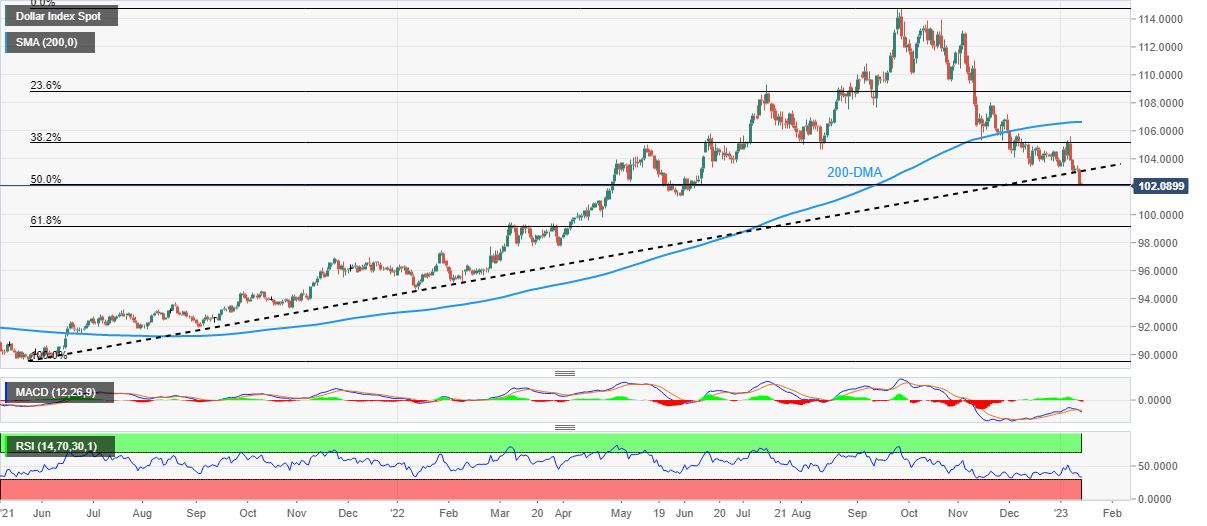- US Dollar Index remains pressured at seven-month low after declining the most in over a week.
- United States Consumer Price Index marked the first contraction since June 2020 and lured DXY bears.
- Federal Reserve officials backed slower interest rate hikes but retreated from policy pivot talks.
- Strong prints of US Michigan Consumer Price Index, 5-year Consumer Inflation Expectations could trigger US Dollar short-covering.
US Dollar Index (DXY) licks its wounds at the seven-month low as bears await more clues to extend the United States inflation-inflicted losses ahead of other key statistics from the world’s biggest economy. Also likely to have probed the DXY bears could be the recent lack of data and fresh geopolitical fears surrounding the US and China. That said, the US Dollar Index seesaws near 102.20 by the press time of early Friday, after falling the most in a week the previous day.
United States Consumer Price Index drowned US Dollar Index
On Thursday, the United States Consumer Price Index (CPI) amplified concerns about the Federal Reserve’s slower rate hikes by printing downbeat numbers for December, which in turn pushed the US Dollar Index to refresh a multi-month low. That said, the headline CPI matched 6.5% YoY forecasts versus 7.1% prior. More importantly, CPI ex Food & Energy also proved the market consensus of 5.7% YoY figure right, compared to 6.0% previous readings. It’s worth noting that the CPI MoM marked the first negative figure since June 2020 while marking a -0.1% figure for the stated month, versus 0.0% forecast and 0.1% prior.
Federal Reserve officials favor slower rate hikes but not pivot talks
Following the downbeat United States inflation data, Federal Reserve Bank of Philadelphia President Patrick Harker was the first to flag easy rate hikes after the US CPI and weighed on the US Dollar. On the same line, Richmond Federal Reserve President Thomas Barkin mentioned that it "makes sense" to steer more deliberately as the Fed works to bring inflation down. However, St. Louis Federal Reserve leader James Bullard also said that the most likely scenario is inflation remaining above 2%, so the policy rate will need to be higher for longer.
That said, the Fed Fund Futures tied to the policy rate implied a nearly 100% chance of a 0.25% Fed rate hike in February while the odds favoring a 50 basis points (bps) rate hike in the said month slumped to 8.0%.
US-China tussles put a floor under the DXY price
Reuters cites anonymous sources to state that the White House will discuss a recent crackdown on exports of chip-making tools to China with Japanese and Dutch officials during upcoming visits. The news also mentions that the White House Officials will not result in "immediate" pledges from the two countries to impose similar curbs. The news refreshes the geopolitical tussles between the United States and China and underpins the US Dollar Index rebound, or at least a pause to the further downside.
More data eyed to confirm US Dollar Index fall
Although the US CPI and comments from the Fed policymakers have highlighted the odds of the Federal Reserve’s (Fed) easy rate hikes from February, talk of the policy pivot need more proofs to gain the market’s attention. Among them, China’s trade numbers for December and the first prints of the US Michigan Consumer Sentiment Index (CSI) for January will be important for immediate direction. Also important will be the US 5-year Consumer Inflation Expectations.
To sum up, US Dollar Index (DXY) remains on the bear’s radar but the room towards the south hinges on more data.
US Dollar Index technical analysis
With its downside break of 103.00, the US Dollar Index smashed the key support line stretched from May 2021. However, the 50% Fibonacci retracement level of the DXY’s May 2021 to September 2022 upside, near 102.15, restricts the quote’s immediate declines.
Even so, the bearish signals from the Moving Average Convergence and Divergence (MACD) indicator keep the US Dollar Index bears hopeful of breaking the immediate support, which in turn highlights May 2022 low surrounding 101.30.
It should be noted, however, that the Relative Strength Index (RSI) line, placed at 14, is near the oversold territory and suggests limited downside room, which in turn adds strength to the 101.30 support.
In a case where the DXY drops below 101.30, the 101.00 and the 100.00 thresholds could probe the bears before directing them to the 61.8% Fibonacci retracement level, also known as the “Golden Ratio”, surrounding 99.20.
Alternatively, the US Dollar Index corrective bounce remains elusive unless the quote stays below the aforementioned multi-month-old support line, now resistance around 103.05.
Following that, the 38.2% Fibonacci retracement and the monthly high could test the DXY bulls around 105.15 and 105.65 respectively.
However, the US Dollar Index remains on the bear’s radar unless the quote stays below the 200-Day Moving Average (DMA) level of 106.65.
DXY: Daily chart
Trend: Further downside expected
Information on these pages contains forward-looking statements that involve risks and uncertainties. Markets and instruments profiled on this page are for informational purposes only and should not in any way come across as a recommendation to buy or sell in these assets. You should do your own thorough research before making any investment decisions. FXStreet does not in any way guarantee that this information is free from mistakes, errors, or material misstatements. It also does not guarantee that this information is of a timely nature. Investing in Open Markets involves a great deal of risk, including the loss of all or a portion of your investment, as well as emotional distress. All risks, losses and costs associated with investing, including total loss of principal, are your responsibility. The views and opinions expressed in this article are those of the authors and do not necessarily reflect the official policy or position of FXStreet nor its advertisers. The author will not be held responsible for information that is found at the end of links posted on this page.
If not otherwise explicitly mentioned in the body of the article, at the time of writing, the author has no position in any stock mentioned in this article and no business relationship with any company mentioned. The author has not received compensation for writing this article, other than from FXStreet.
FXStreet and the author do not provide personalized recommendations. The author makes no representations as to the accuracy, completeness, or suitability of this information. FXStreet and the author will not be liable for any errors, omissions or any losses, injuries or damages arising from this information and its display or use. Errors and omissions excepted.
The author and FXStreet are not registered investment advisors and nothing in this article is intended to be investment advice.
Recommended content
Editors’ Picks
EUR/USD extends gains above 1.0700, focus on key US data

EUR/USD meets fresh demand and rises toward 1.0750 in the European session on Thursday. Renewed US Dollar weakness offsets the risk-off market environment, supporting the pair ahead of the key US GDP and PCE inflation data.
GBP/USD extends recovery above 1.2500, awaits US GDP data

GBP/USD is catching a fresh bid wave, rising above 1.2500 in European trading on Thursday. The US Dollar resumes its corrective downside, as traders resort to repositioning ahead of the high-impact US advance GDP data for the first quarter.
Gold price edges higher amid weaker USD and softer risk tone, focus remains on US GDP

Gold price (XAU/USD) attracts some dip-buying in the vicinity of the $2,300 mark on Thursday and for now, seems to have snapped a three-day losing streak, though the upside potential seems limited.
Injective price weakness persists despite over 5.9 million INJ tokens burned

Injective price is trading with a bearish bias, stuck in the lower section of the market range. The bearish outlook abounds despite the network's deflationary efforts to pump the price.
US Q1 GDP Preview: Economic growth set to remain firm in, albeit easing from Q4

The United States Gross Domestic Product (GDP) is seen expanding at an annualized rate of 2.5% in Q1. The current resilience of the US economy bolsters the case for a soft landing.
